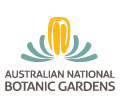 |
In Flower This WeekA weekly news-sheet prepared by a Gardens volunteerNumbers in brackets [ ] refer to garden bed 'Sections'. Plants in flower are in bold type. |
 |
In Flower This WeekA weekly news-sheet prepared by a Gardens volunteerNumbers in brackets [ ] refer to garden bed 'Sections'. Plants in flower are in bold type. |
The walk this week is up to the Rock Garden where the small plants are kept warm by the heat stored in the rocks. On the way is Micromyrtus ciliata [Section 10] which covers a large area along the border of the bed and, with tiny pink buds still to open and it equally tiny white flowers that are already out, is a very pretty plant. Further on is Rhagodia spinescens [Section 110], commonly known as the Grey Salt Bush, not in flower, but its foliage is a good colour contrast with the plants around it.
On to the Rock Garden, where, on the left, is Actinotus helianthi ‘Federation Star’ [Section 15c]. Past its best but still attractive and, as it celebrates 100 years of Federation, it is well worth reading the sign for more information. Banksia integrifolia var. integrifolia [Section 15c] is a low sprawling plant with one lone, yellow-green cone still in good condition. Cryptandra scortechinii [Section 15c], two plants, both just coming into flower with lots of unopened red-brown buds and some woolly white flower heads. Homoranthus darwiniodes [Section 15f], a plant that always seems to be in flower, is a grey bush covered in tiny, pendulous cream flowers, lots of them beginning to turn red with age. Just behind it, but more compact, is Eremophila maculata var. brevifolia [Section 15f]. A grafted plant with numerous dark red flowers, each one held on a very thin stem.
Hakea corymbosa [Section 15p] is nearly two metres tall, with very dense foliage and rigid, spiky leaves. The flowers seem to nestle into the axils of its leaves and are a greenish yellow colour with orange styles protruding. Close by is Grevillea stenomera [Section 15p] a small tree set back a little in the garden, with very dainty cream and red flowers. Leucopogon fraseri [Section 15k] is a rather compact shrub with slightly reddish foliage and reddish, tubular flowers. Acacia costiniana [Section 15k] is a low-growing wattle with deep yellow flower balls. Grevillea lanigera [Section 15h] is another prostrate plant with dark red flowers, some of which have finished and turned nearly black.
Turn left to walk back to the car park. Along the way is Dampiera linearis [Section 17], a small plant with equally tiny bright blue flowers, and Acacia aphylla [Section 17], with small, upright, smooth, spiny branches with the more usual globular yellow wattle flowers. Gahnia clarkei [Section 80] is a vigorous plant with large leaves that have rough edges. Its flower heads are coming out a shiny, light brown, turning to dark brown when past their best. At the edge of the Brittle Gum Lawn is Banksia spinulosa var. spinulosa [Section 107] bearing large golden flower spikes with protruding red styles. The birds love it!
Enjoy!
Naomi Bell
| Return to: | Australian National Botanic Gardens | Previous
'In Flower' Weeks |